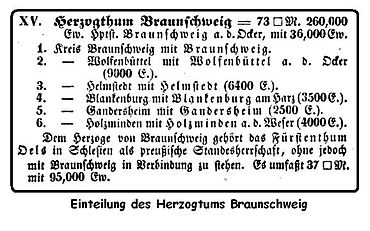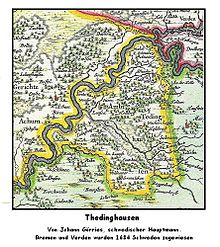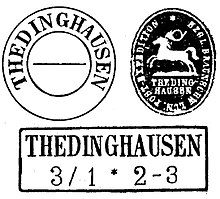Post route Braunschweig – Hildesheim
The Braunschweig – Hildesheim postal route is about the traveling and riding posts from Hildesheim to Braunschweig . The article also deals with the postal history of the places Bettmar , Vechelde and Thedinghausen in the Braunschweig district in the duchy of the same name. The postal stories of Lehr and Immendorf are assigned to the postal routes Braunschweig – Calvörde and Wolfenbüttel – Harzburg , respectively . The following articles report on the postal history of the city of Braunschweig: Braunschweiger Postanstalten and Braunschweiger Poststempel .
At the beginning of the 19th century, the Duchy of Braunschweig covered 4020 km² with 260,000 inhabitants. The capital Braunschweig an der Oker had 36,000 inhabitants.
Preliminary remark
Until April 1, 1833, the management of the Ducal Brunswick State Post was the responsibility of the Hof Post Office in Brunswick. By postal ordinance, this task was assigned to an independent postal administration. The postal regulations (from 1766, 1790 and 1796) ensured the security, speed and convenience of the posts.
The Hof post office was housed in a building on Kohlmarkt (today Karstadt furniture store). Postmasters were employed in Wolfenbüttel , Helmstedt , Seesen , Holzminden and Blankenburg . The other postal workers on the wards carry the title of post holder.
The following post offices were subordinate to the Hof-Postamt Braunschweig: Bettmar, Lehr, Wendhausen , Exklave Ölsburg , and Vechelde . All other places had to arrange a messenger mail to the nearest post office at least once a week.
One form of messenger post was that a local resident had to go in alternating order as a "messenger in line". Often it was the community servant who took on this service. The letters had to be handed in or picked up by the messenger in so-called “mailboxes” or “letter collection points”.
In the vicinity of the city of Braunschweig, letters and small parcels have been ordered and collected by country postmen since 1838. Over time, this was the rule across the country.
Bettmar
In the archive for modern history from 1786 you can read: “ Besides the Braunschweigische Post there is also an imperial one here (in Braunschweig). The outfit of the local imperial postilions is turned up in brown and yellow with yellow buttonholes. About Lehndorf Raffturm , Fecheln (Vechelde) , Bettmar, Großenlaffer ( United Lafferde ) , we went to the pen Hilde Local Gleidingen, here is an imperial post house for riding post. Horses are changed in Gleidingen, horses are available from the imperial post office in Hildesheim. The postilions there have turned up gray coats and yellow hats with the double eagle. It is halfway between Braunschweig and Hildesheim. "
After the dissolution of the Kingdom of Westphalia , the state government decreed on January 22, 1814 to make Bettmar the seat of a district court. Since then, Bettmar has also had a post office attendant. When, in 1825, the Bettmar District Court was relocated to the neighboring Vechelde with the restitution of the Vechelde Office , the post guard was lifted. Only handwritten place notes were found on letters.
A post office with a horse station was opened in Bettmar in 1892 . Georg Reinecke was the first post agent until 1896. Wilhelm Frick (1907 to 1912) and Paul Mielke (1914 to 1916) are named as country mail carriers in the address books.
Vechelde
After the abolition of Postwärterei in Bettmar received Vechelde 1825 a post expedition . Since then, the one-liners have been found, mostly with a handwritten date. Under the postal expedition Heinrich Friedrich Hansemann (term of office from 1833 to 1853) the stamps were knocked off in black. His successor Theodor Ludwig Borchers (1854 to 1866) received the rectangular stamp in 1854 . The postal expedition stamped in blue. The stamps were canceled from 1856 with the rust-diamond cancel "43".
After long negotiations, the Duchy of Braunschweig had reached an agreement with the kingdoms of Hanover and Prussia to build a railway connection from the Prussian Minden via Hanover to Braunschweig. Construction began in 1842. The line from Hanover to Lehrte was opened on October 22nd, 1843. From December 3, 1843 it went to Peine and on May 19, 1844 to Braunschweig. The section in Brunswick was also operated by the Hanover State Railway.
By law of January 22, 1855, the administration of Vechelde was given the name: Rail and Post Expedition.
The Braunschweig advertisements of August 29, 1865 read: “ From September 1, mailboxes can also be sent to the Royal Prussian railroad mail car passing through the Duke of Brunswick at the local stations Jerxheim , Schöppenstedt , Wolfenbüttel , Braunschweig and Vechelde Posting of undeclared letters, regardless of destination, can be used. The condition is that these letters, which are to be conveyed in this way, must be franked or franked by stamps or envelopes. signed Schottelius. "
Robert Schneider (1890 to 1912) ran a post office in Alvesse (-Vechelde 13).
Thedinghausen
The Thedinghausen office was transferred to the Kingdom of Sweden through the Peace of Westphalia of 1648 with the Archbishopric of Bremen , to which it belonged . In 1679 the Swedish crown had to cede the Thedinghausen office and Voigtei Dörverden to the House of Braunschweig-Lüneburg . They initially administered the land collectively. Rudolf-August von Braunschweig offered to swap his share for the offices of Gifhorn , Fallersleben , Campen and Meinersen . On November 12, 1681, the old Thedinghausen office was divided. Part of the district court Thedinghausen with eleven communities received the Wolfenbüttel line . On June 30, 1972, after 300 years, the district of Braunschweig said goodbye to Thedinghausen.
In 1703 the mint was Brunswick and the weight was Bremen.
The mail had been routed through the Hanoverian Achim , as a handwritten note "de Achim" and a probably Westphalian one-liner ACHIM suggest.
During the Westphalian period, Thedinghausen was in the department of the Weser in the Rinteln district and from January 1, 1811 to November 10, 1813 in the department of the Elbe and Weser estuaries , Verden district .
From a postal facility, we learn by the Circular 13 of the Brunswick Post of 28 March 1851. "§ 2 From 1 May 1851 is in Thedinghausen a post expedition in efficacy occur". District court clerk Koldewe (1851 to 1852) becomes the first postal expedition. He uses the two-circle stamp with a date line. Members of the Hartmann family (1852 to 1873) received the rectangular stamp in 1855 . Since 1856 the postage stamps with the rust-diamond cancel with the number "42" have been canceled.
For the development of the postal system in teaching, see: Post route Braunschweig – Calvörde
literature
- Henry Bade: 333 years of the Braunschweigische Post, 1535–1867. Karl Pfankuch & CO, Braunschweig, 1960. This is where the stamp images come from.
- Hans-Joachim Anderson: The designation of the postmark forms. Düsseldorf 1970, postmark guild “Rhein-Donau e. V. "(The attempt of the Federation of German Philatelists to achieve uniformity in the stamp descriptions)
- Handbook about the Kingdom of Westphalia. bey Hemmerde and Schwedtschke, Halle 1808.
- Werner Steven: Table of contents of the postal relevant Braunschweigischen Ciculare, laws and ordinances from 1807 to 1867. Circular letter No. 58, Arbeitsgemeinschaft Braunschweig and Hannover in the Briefmarken-Club Hannover, April 2004.
- Werner Steven: Directory of post offices and their staff in the area of the Duchy of Braunschweig, 1811-1916. Society for German Postal History e. V. Braunschweig / Hanover district group. Issue 13 of the Postal History Pages, 1992.
See also
- Duchy of Brunswick
- Postal history and postage stamps of Braunschweig
- Braunschweiger Poststempel , An overview of the forms of the Ducal Braunschweig-Lüneburg postmarks
- Brunswick coin history
- Brunswick finance laws
- Postal history of the Kingdom of Westphalia
- Napoleonic Post in Northern Germany
- Brunswick post offices
- Postal organization
- Post route Braunschweig – Calvörde (Bahrdorf, Calvörde, apprenticeship, Velpke, Vorsfelde)
- Postal route Braunschweig – Helmstedt – Magdeburg (Helmstedt, Hessen am Fallstein, Groß Winningstedt, Jerxheim, Königslutter, Schöningen, Schöppenstedt),
- Post route Braunschweig – Blankenburg (Blankenburg, Braunlage, Hasselfelde, Hohegeiß, Rübeland, Tanne, Walkenried, Zorge)
- Postal route Wolfenbüttel – Harzburg (Börßum, Harzburg, Immendorf, Lesse, Oker, Salder, Wolfenbüttel)
- Postal route Braunschweig – Göttingen (Badenhausen, Barum and Klein-Rhüden, Bodenburg, Delligsen, Gandersheim, Gittelde, Greene and Kreisensen, Langelsheim, Lutter am Barenberg, Mühlenbeck, Naenesen, Seesen)
- Post route Braunschweig – Holzminden (Amelunxborn, Bevern, Bisperode, Eschershausen, Fürstenberg, Halle on the Weser, Holzminden, Hehlen, Mainzholzen, Ottenstein, Stadtoldendorf, Vorwohle, Wickensen).
Individual evidence
- ↑ Georg Hassel and Karl Bege : Geo-statistical description of the principalities of Wolfenbüttel and Blankenburg . First volume, Culemann, Braunschweig 1802
- ↑ Johann III Bernoulli : Archive on modern history, geography, knowledge of nature and people . Volume 5, Georg-Emanuel Beer, Leipzig 1786.





